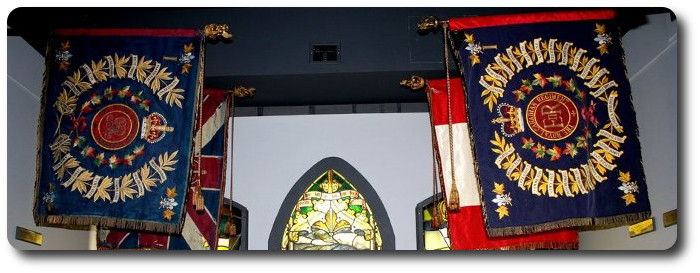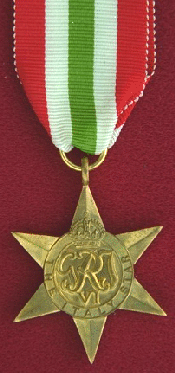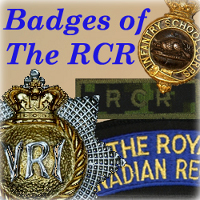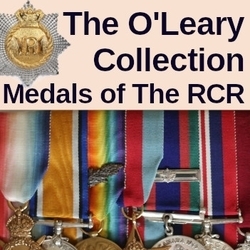
Researching The Royal Canadian Regiment

The Italy Star was awarded for one day operational service in Sicily or Italy between 11 June 1943 and 08 May 1945.
The Battle of Nissoria; 24 July 1943
The Connecting File, October 1946
By: Major C. H. Lithgow
Major C. H. LITHGOW was commissioned from R.M.C. in June, 1940, and proceeded overseas in October, 194&. He joined the Regiment in Apr., 1942, and saw continuous service with the battalion from then until December, 1943, when he was seriously wounded in the attack on Dundee Cross-roads. He was Signal Officer, later commanded "B" and "D" Coy's until wounded, and then returned to the U.K. as an instructor.
The Sicilian Campaign is just two weeks old and already there are memories … the deathly stillness of ROSOLINI … a wild night ride on tanks … a magnificent traffic jam at SAN MICHELE. … the smell of CALTAGIRONE. … an attack "according to the book" at V ALGUARNERA. … Major Pope's death … a mad dash up the ASSORO peak with rations for the HPE … and now it is 24 July, '43.
After the capture of LEONFORTE by the Second Canadian Infantry Brigade, the Division swung eastward from ASSORO towards NISSORIA, AGIRA, REGALBUTO and MOUNT ETNA, and on this morning the battalion was resting beside the LEONFORTE-REGALBUTO road about four miles west of NISSORIA. It had been a hectic night advance and all ranks were resting or tidying up as well as they could.
At about 1000 hrs. Lt.-Col. Crowe returned from an "O" Group at Brigade H.Q. and called the company commanders together., Orders were issued for an attack on the hilltop town of AGIRA, a pinnacle in the rolling countryside about five miles east of NISSORIA and nine miles east of the present location. The plan called for C and D companies right and left forward to capture the high ground immediately east of NISSORIA, at which time A and B companies would pass through and take AGIRA. In support of the attack would be tanks of the Three Rivers Regiment, the Divisional Artillery and a newcomer to our operations, medium and fighter bombers of the R.A.F.
Immediately following the "O" Group the company commanders moved forward with the C.O. A reconnaissance was made from a hill about two miles east of NISSORIA and this feature was chosen as the start line. Ahead lay undulating ground covered with olive orchards and grapevines while NISSORIA looked white and deceptively clean in the burning sun. On the far side of the town, our intermediate objectives were two hills north and south of the white, winding road. On the northernmost of these was a red building, the only splash of colour in an otherwise drab picture.
H hour had been set for 1400 hrs and the battalion was already moving forward on the dusty road. Just before noon they entered the FUP with all companies on the right of the road.
Everyone was in good spirits as the artillery barrage began its solid pounding and the troops plunged forward over the terraced hillsides towards NISSORIA. The companies moved easily at first but with ever increasing difficulty over some of the steep slopes, and the barrage, lifting a hundred years in two minutes began to draw ahead leaving an increasing gap between it and the forward troops. About one mile from the start line, D and B companies crossed to the north side of the road and the advance continued with the inner flanks. of the companies moving on the road.
The Command Post moved on the axis just behind the leading elements. As the guard levelled out near NISSORIA, the tanks deployed to either side of the road.
It had not been anticipated that NISSORIA would prove much of an obstacle, and in fact, the enemy had shown no reaction up to this point. It was almost a training picture … the irregular line of troops moving steadily forward… shouts and hand signals from officers and N.C.O.'s controlling the advance… the "clank" and whine of the Shermans as they lifted great clouds of dust… and in the distance the artillery laying a smoky, metal pall over the hills.
All at once, with a shriek and a "crump" the enemy mortar fire fell upon the reserve platoons of the leading companies. Fortunately it was behind the forward troops and only became truly effective as they broke into the western section of the town. House clearing was begun automatically, but with a difference … all the doors were locked and neither LMG nor Tommy gun fire would open them. This took everyone aback momentarily but it was decided to move on and assume the buildings empty, which indeed they were, for the inhabitants had fled.
The Germans were by now "throwing the book" at the battalion and there were some casualties. As the move through the town and to the far side progressed, the enemy fire increased in intensity and the eastern exit of the town, a natural defile, was well covered.
Rather than attempt to break out of the town at this point, the commander of D company swung his troops to the left and ordered the advance to continue out the north side of the town. An order to "Push on" given by Colonel Crowe over the wireless failed to reach D company and as a result, A, Band C companies moved to the right and by-passing the German position sped through the hills towards AGIRA. It was at this time that the battle broke up into two distinct phases. It was almost impossible to shout now for the rattle of machine guns, the constant "crump" of mortar fire and the high pitched "crack" of the 75 mm. guns erased all other sound.
The move of D company was carried out, but not without confusion, for changes of plan in the middle of a battle are difficult of execution. By about 1630 hrs. a small party of D company personnel were gathered in the valley just east of the town and about two hundred yards north of the axis. On the road were several burning Shermans of the Three Rivers Regiment, all victims of an enemy gun apparently situated near the red building mentioned earlier.
Under the company commander, the men began the ascent of the hill on which the building was located. Moving in extended line they clambered up the terraces to the crest and then moved southward towards the road. A silence had dropped around the battle as they 'crept forward encountering the enemy.
Suddenly a shout. Cpl. Hawke, F. R., had spotted Germans behind a waist high rock wall about thirty feet from the party. They had lain "doggo" until now, when a hail of "potato mashers" and Schmeisser fire was opened. A battle erupted at once with grenades, rifles and Tommy guns being used freely. Cpl. Hawke distinguished himself in this acti~n and was awarded the Military Medal. All at once, off to the right near the road, with a labouring whine, a Mk. III tank appeared, machine-gunning the grape vines in which our men were crouched. Armed only with rifles and Tommy guns, the party was forced to withdraw to the bottom of the hill and there the seven men gathered.
It was decided to try and link up with C company who were supposed to have captured the hill on the opposite side of the road. In the gathering dusk, and by flickering light cast by the burning tanks the men crossed the road and commenced to climb the other hill. Capt. Couche, the company second in command, had now joined the group and had brought with him a few others who increased the total strength to about fifteen.
A burst of German machine gun fire interrupted the climb, but only for a split second. A spirited charge was made and seventeen prisoners were taken at the cost of a slight wound to L/Cpl. Berube. It was dark now and a perimeter was formed while the Germans sat uneasily with their backs to one of the terraces under the watchful eye of Pte. Kelly. In the course of investigating a nearby cave a cache of German pistols was found which were quickly seized by the men as souvenirs. Presently, contact was made with a sergeant tank commander of the Three Rivers Regiment whose tank was the only one to escape the enemy fire. He reported that there were no troops of ours on the hill and that he was going to attempt to withdraw to the town with his tank. A few minutes later, with a roar and a whine he clattered down the road toward NISSORIA, German tracer floating after him but never quite catching up. The flames of the burning tanks were beginning to die down and darkness settled upon the scene.
After some deliberation it was decided to return to the town, as certain the battalion position, pick up stragglers and return to the hill. The prisoners were sent first under Pte. Kelly while the remainder followed under cover of the darkness.
They were met at the gate of the town by Capts. Mitchell and Dillon and Lt. Hunt. Bn, H.Q. and a part of F Echelon had moved into the town and the vague, bulky shapes of vehicles could just be distinguished, sometimes illuminated in the glow of a cigarette. Voices normally quiet seemed more subdued than usual and the reason for this was readily discovered. Colonel Crowe had been killed. Pushing ahead with his signallers and expecting to find A and C companies on the hill south of the road, he had been caught in an enemy position. His signallers, Ptes. Cummings and Turner, were both dead and Sigmn. Burton of the R.C.C.S. was a prisoner. It was a bitter blow for Colonel Crowe had lived for the Regiment and his place would not easily be filled.
The battle had quietened and the only sounds were subdued talking, the clatter of the RAP jeep as Ptes. Bean and Bailey moved casualties back to the Field Ambulance and the distant "wump" of a German gun with its subsequent "swish-wish-wish" and the final ear splitting crash somewhere in the town. After a smoke and a mouthful of bully-beef steps were taken to gather up the stragglers and after a brief delay about two platoons were standing ready to move off. At this time Lt.-Col. Lord Tweedsmuir, the O.C., the HPE arrived to say that his battalion was to make an attack and to ask for someone to guide them forward. A night recce patrol was despatched under Sgt. Boone, later killed in the LIRI VALLEY, to ensure that the approaches were clear of enemy and to bring back any information possible.
About twenty minutes later the R.C.R. party under O.C. D company and the H.P .E. under their C.O. moved off, ascending the hill on the right of the road and moving along the crest. After a few minutes Sgt. Boone was met and he reported that he had encountered no enemy. At this point the H.P.E. continued their advance while the R.C.R. group dug in for the balance of the night.
As D Coy. entered the town A coy. linked up with C. Coy who had been forced to the south of their axis by a series of very rugged ravines which had not shown on the map. Immediately afterwards A coy. commenced to descend a very bald slope below the town cemetery, moving toward the spur on the eastern outskirts of Nissoria. It was at this point that the enemy suddenly became very belligerent, and a literal hail of 81 mm mortar and 25 mm. AA/Ground fire descended on our helpless heads. There was absolutely no cover to take (except in a withdrawing direction) and the enemy were out of Bren range, so the line was further extended and the advance continued at an accelerated pace. Individual tps. hit the dust as bombs came close enough to make a very distinct whistling sound and pushed on through the dust and smoke as soon as the bomb had gone off.
The noise and heat were sufficient to make the whole thing seem. unreal, the effect therefore was somewhat exhilarating rather than terrifying (as was later learned from prisoners) and was very disconcerting to the enemy who saw troops advancing steadily through all the fire they could produce with no apparent slackening. It was, in fact, from prisoners taken in this battle, that the expression "Red Patch Devils" became a title later applied to the whole of 1 Cdn. Inf. Div.
A company finally reached a slope at right angles to the enemy position on the spur, and from positions behind stone fences began to harass the enemy flank. The enemy apparently had lost track of them somehow and the answering fire seemed very casual. As C and D Coys. were now attempting a frontal assault, and having very apparent difficulty, the O.C. A company decided to put in a lane attack, taking the enemy in the flank, reasoning that—
1. Either the enemy would turn to fight off this new threat, there": by giving Band C Coys. the necessary chance, or
2. was so busy with Band C Coys. that A Coy. would have a surprise effect and a very good chance of taking the position.
One large fly had entered the ointment, however, in the form of the A company 18 set which was out of order. As there was not time for a runner to get through to Tac. H.Q., the O.C. A Coy launched his attack immediately, trusting that his action would be seen and correctly interpreted by the other companies, the information passed to Lt.-Col. Crowe and the play backed. This attempt was going ahead, 7 and 9 platoons were halfway up the enemy-held slope and while meeting an uncomfortable amount of opposition were making steady progress when word was shouted to the coy. comd. from B Coy. area that the 25 pdrs. were going to have another go at the positions. Apparently the arty. had been turned on where A Coy. commenced their attack. A Coy. was therefore hurriedly pulled back to the bottom of the hill where A and B Coy. comds. discussed with the C.O. by means of the B Coy. 18 set.
Lt.-Col. Crowe ordered A and B Coys. to push on toward Agira, as it had now been found possible to by-pass the enemy position. This was done at once but as A Coy. H.Q. and 9 Pl. could not be located in time A Coy. consisted of 7 and 8 platoons, the Coy. comd. and his runner. The remainder of Coy. H.Q. and 9 platoon being unable to find A Coy in all the dust, noise and confusion joined a small battle group under Capt. R. M. Dillon, M.C., the carrier officer, for the remainder of the battle.
The by-passing of the main enemy position was carried out without any real trouble, and A and B Coys. streaked up a heavily wooded valley towards Agira. The next passing-through point (known as "Crowe Line") was reached without any excitement and Agira would be plainly seen about a mile to the east. By now, A and B Coys. were out of range of Tac. H.Q. by 18 set, but were in radio contact with Coy. which was coming up about 900 yards behind and who were j contact with Tac. H.Q.
A guide was sent back to bring C Coy. up to A and B Coys. but returned almost at once with the news that he had heard about platoon of the enemy coming in from the north. He again set out to contact C Coy. with orders to bring C Coy. to A and B Coys. from the south as that seemed the safest route. Meanwhile A and B Coys. took up positions higher up the slope from where they gave the expected enemy patrol aver rough brush-off.
On the arrival of C Coy. a council of war was held by the three Coy comds. Capt. I. A. Hodson (commanding C Coy.) had been in contact by radio with Col. Crowe during the past 15 minutes, and had reported his position as well as that of A and B Coys., but that Crowe Line was not to be passed until word was received from him. The three Coys. therefore consolidated to hold the line until D Coy. come up and the advance was resumed.
Darkness approached with no further word from Tac. H.Q., and now both Coy. 18 sets were unable to reach back to Nissoria.
Another council of war was then held. Two courses were open:
1. To push on and assault Agira under cover of darkness. As no sp. was available this would be done by stealth as a sort of commando grab.
2. To firm up on the present position, sending a small patrol back to Nissoria for further orders and further patrolling around the perimeter for local protection.
The latter plan was decided upon, as Capt. Hodson had received very definite orders from Col. Crowe personally which ruled out a further advance without orders.
The night passed quietly but not very comfortably, stomachs were beginning to feel somewhat empty and a raw cold wind sprang up.
At first light, the contact patrol to battalion had not returned and firing could be heard coming towards the position from Nissoria. It was assumed that this would be the rest of the battalion coming up so a patrol was sent out to guide them in. The fighting was being done by A Coy. H.P.E.R., however, and as they were considerably north of the A, B, C Coy axis they were meeting very heavy opposition. It was found impossible to attract the attention of the HPER either by radio or by firing, and finding the enemy positions too strong they were forced to withdraw before patrol contact had been made.
After this, quiet settled down again. The enemy positions had been located, they had also located our area but the open nature of the ground and lack of sp. arms prevented anything decisive being done about it by either side.
About 1400 hrs. Pte. Cartmill of A Coy. reported to his Coy. that a figure had been seen down the valley towards Nissoria semaphoring "RCR" in the direction of One of A Coy's. sec. positions. The sec. which had noticed him had not answered him, suspecting a ruse by the enemy to locate our positions. A Coy. comd. and Pte. Cartmill then moved well clear of the Coy. position, establishing contact (by semaphore) with the mysterious figure. This figure turned out to be Capt. Dillon with a sec. of carriers. He had reasoned that as no survivors of the three Coys. had rejoined the battalion during the night the Coys. must be established somewhere towards Agira as 100ro killed seemed very unlikely.
Capt. Dillon also brought the uncomfortable information that our artillery were about due to shell the position, as the presence of our troops there were not known. The position was therefore evacuated without delay, the more seriously wounded were taken out by carrier and the remainder made a hot dusty march (without any opposition) back to the original start line. As A, B, and C Coy personnel had not eaten in over 24 hrs. this march seemed somewhat long especially for the walking wounded.
On eventually rejoining the battalion, it became evident that the death of Lt.-Col. Crowe had occurred almost immediately after his radio conversation with Capt. Hodson, and before he could pass this information. As none of his signallers had survived, there was no way of anyone at Tac. H.Q. or at Bde. H.Q. knowing the position of the three fwd. Coys. who were more or less written off when they failed to appear by first light.
On the following morning orders were received to withdraw into the town as an artillery programme was to be brought down on the hill in support of an attack by the 48th Highlanders. Nothing further had been seen or heard of the attack by the HPE but it was later discovered that it had been broken up the night.
Early in the morning, the fore, the composite party withdrew from the hill into the town where it encountered the other companies returned from their foray into the area around AGIRA. The whole battalion then moved back about two miles under Major Powers, the acting C.O., while the Second Brigade prepared an attack on the position.
To reflect upon a battle is so ten to say, "If this had happened …" or "If that had happened…" To do so in this manner is idle a worthless for it tells us nothing. What, therefore, does this battle tell us? It speaks of the loss of a gallant Commanding Officer and too many grand soldiers … all Royal Canadians. It speaks of a fair price exacted for the enemy's tenacity and above all, a determination, yes, an eagerness, to get forward. That is what counted.


